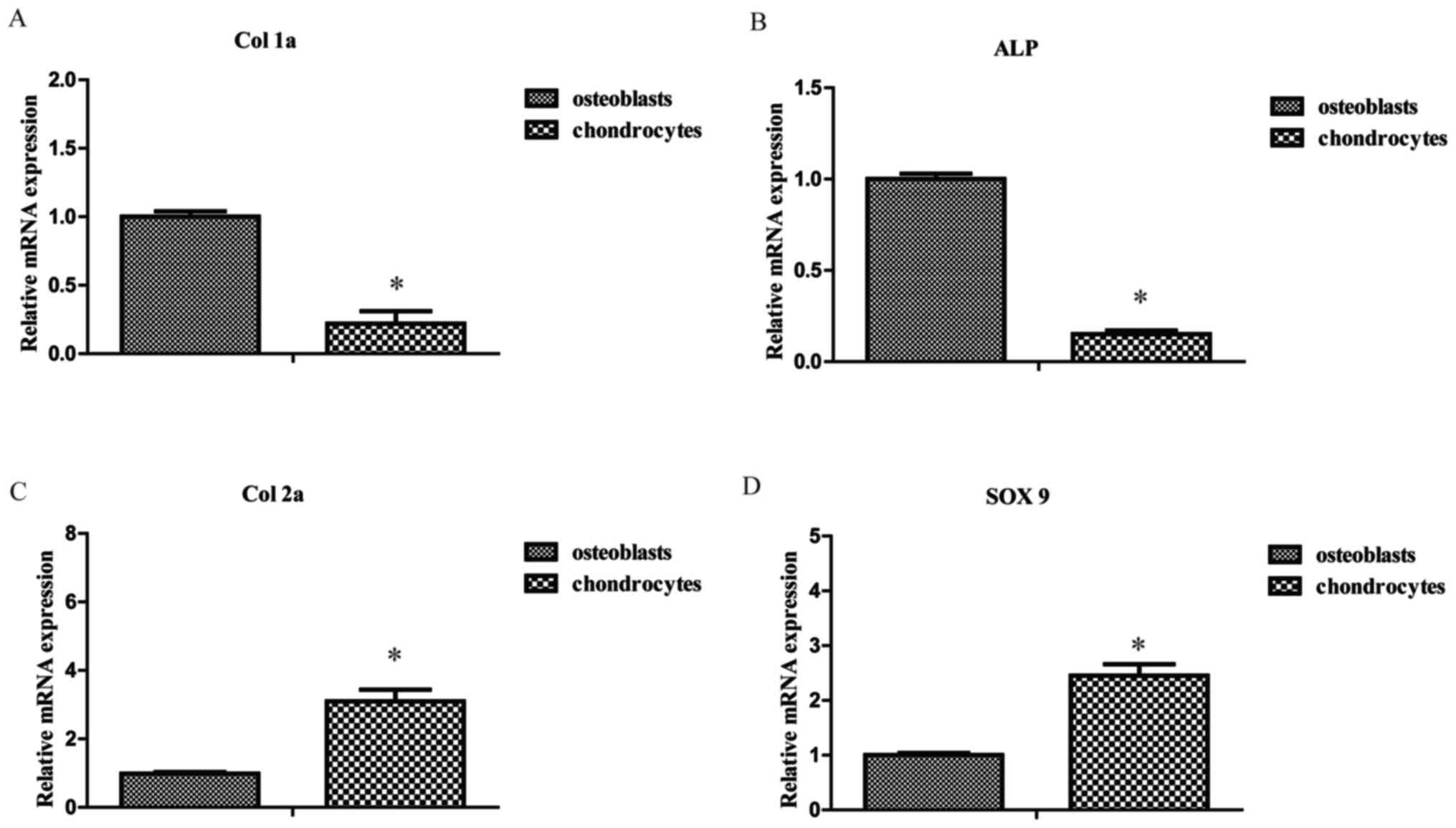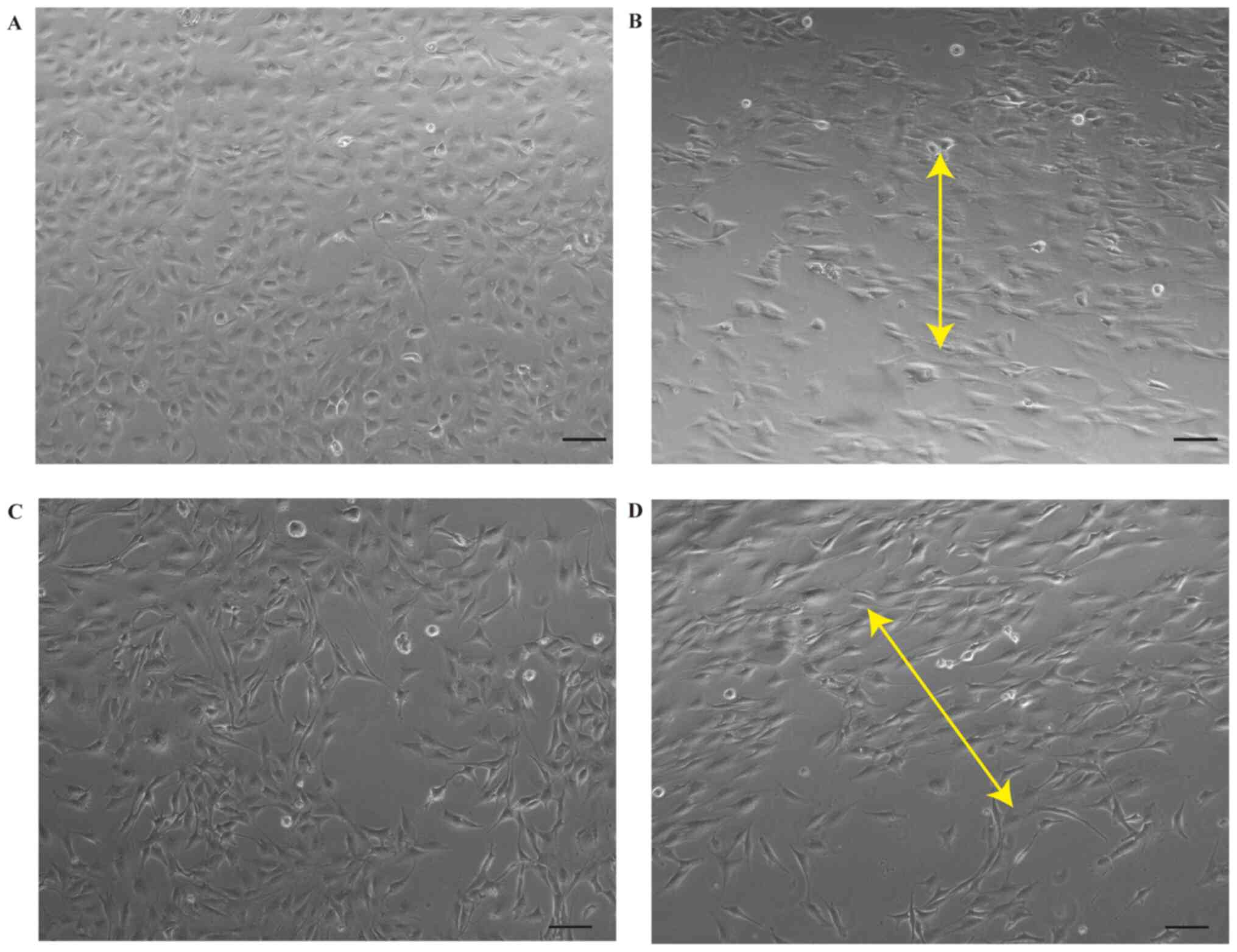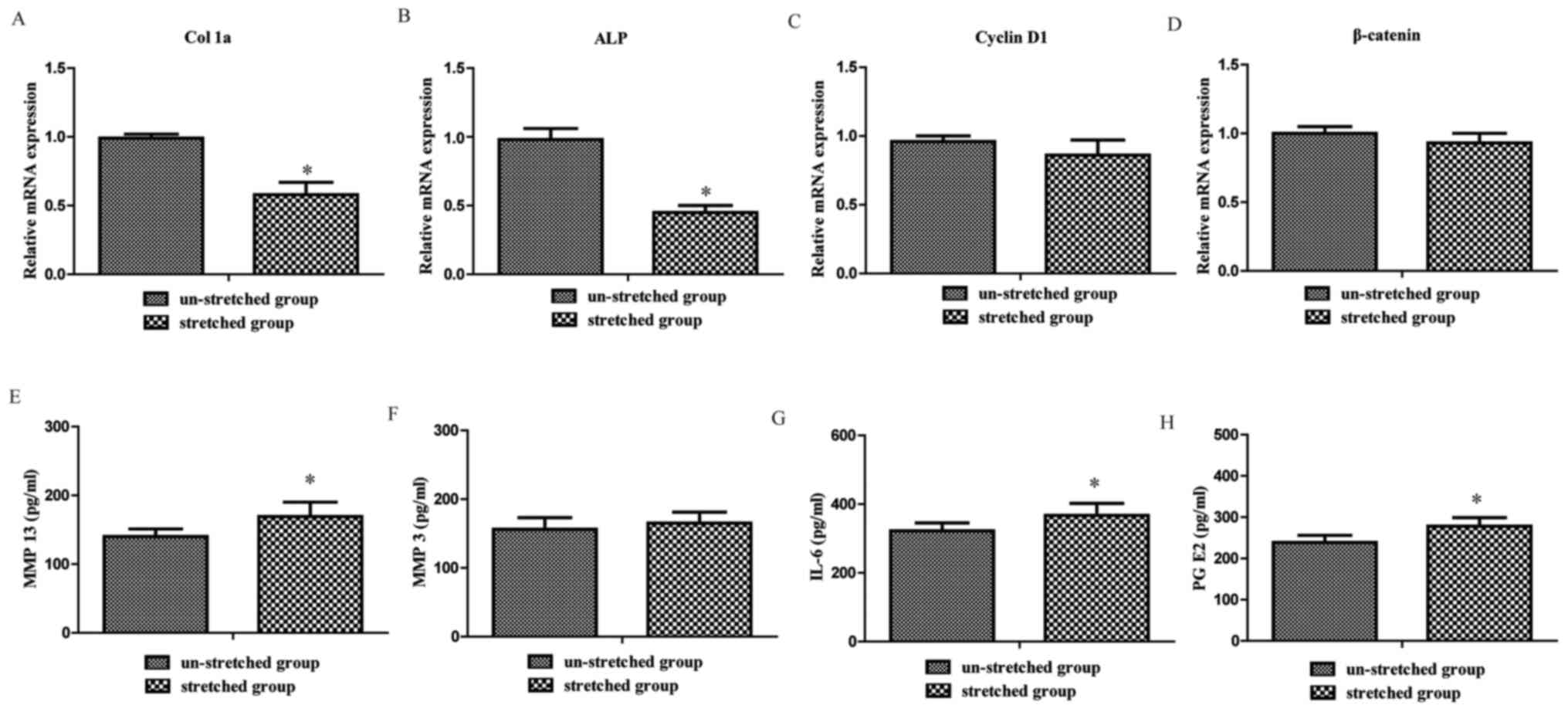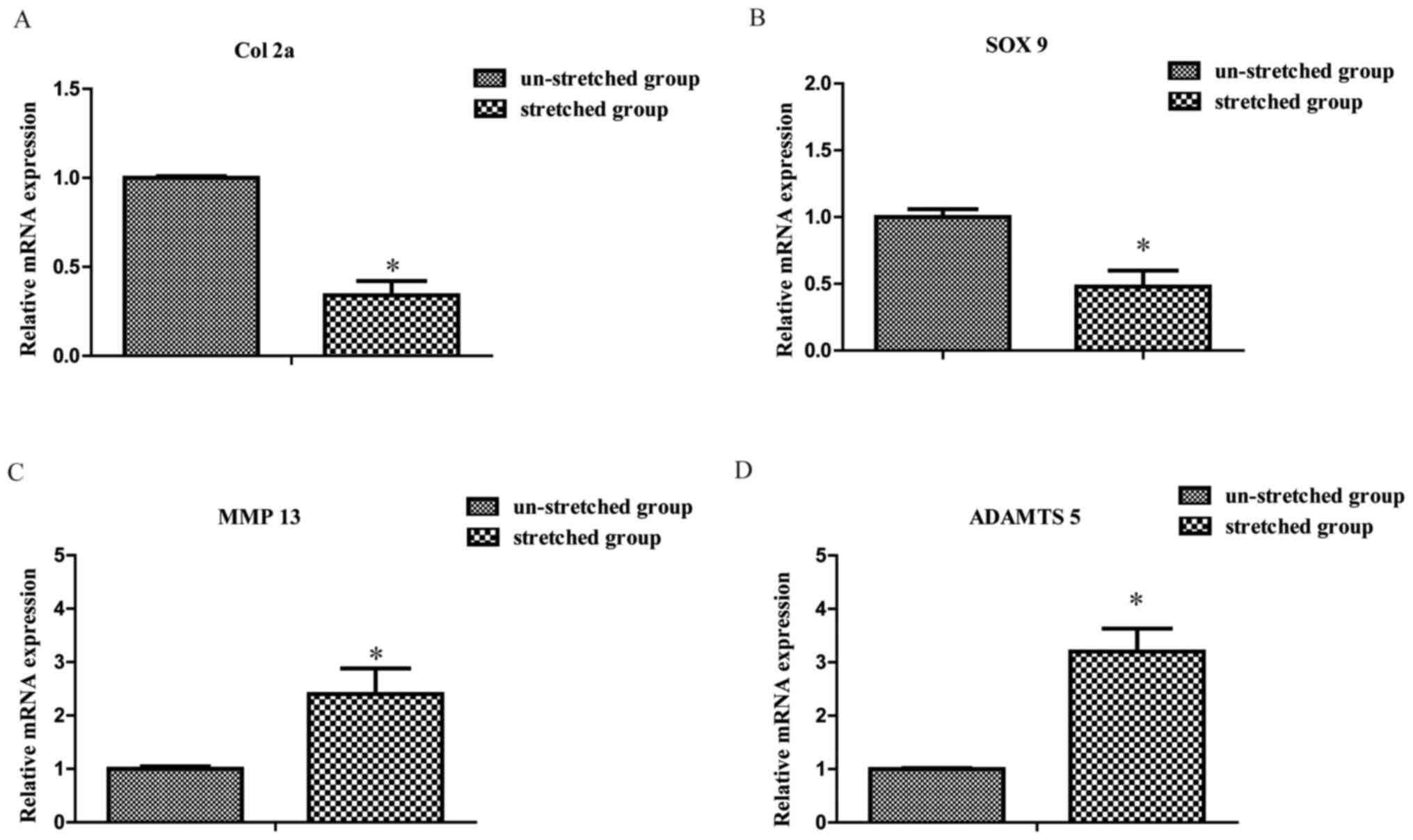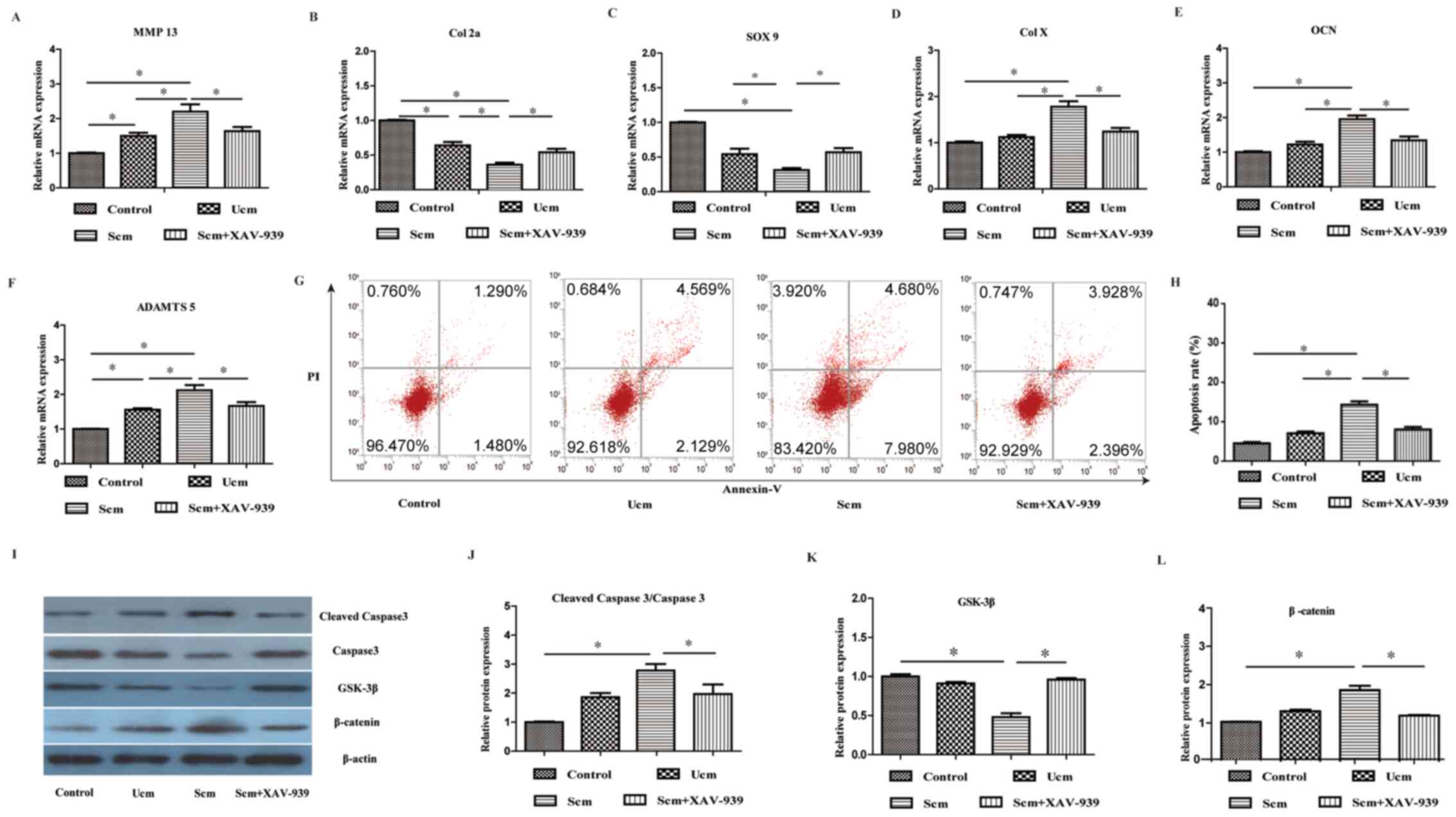|
1
|
Bijlsma JW, Berenbaum F and Lafeber FP:
Osteoarthritis: An update with relevance for clinical practice.
Lancet. 377:2115–2126. 2011. View Article : Google Scholar : PubMed/NCBI
|
|
2
|
Bowden JL, Hunter DJ, Deveza LA, Duong V,
Dziedzic KS, Allen KD, Chan PK and Eyles JP: Core and adjunctive
interventions for osteoarthritis: Efficacy and models for
implementation. Nat Rev Rheumatol. 16:434–447. 2020. View Article : Google Scholar : PubMed/NCBI
|
|
3
|
Qian J, Liang J, Wang Y and Wang H: Effect
of passive motion on articular cartilage in rat osteoarthritis. Exp
Ther Med. 8:377–383. 2014. View Article : Google Scholar : PubMed/NCBI
|
|
4
|
Ni GX, Liu SY, Lei L, Li Z, Zhou YZ and
Zhan LQ: Intensity-dependent effect of treadmill running on knee
articular cartilage in a rat model. BioMed Res Int.
2013:1723922013. View Article : Google Scholar : PubMed/NCBI
|
|
5
|
Goldring MB and Goldring SR: Articular
cartilage and subchondral bone in the pathogenesis of
osteoarthritis. Ann N Y Acad Sci. 1192:230–237. 2010. View Article : Google Scholar : PubMed/NCBI
|
|
6
|
Goldring SR and Goldring MB: Changes in
the osteochondral unit during osteoarthritis: Structure, function
and cartilage-bone crosstalk. Nat Rev Rheumatol. 12:632–644. 2016.
View Article : Google Scholar : PubMed/NCBI
|
|
7
|
Yao Z, Chen P, Wang S, Deng G, Hu Y, Lin
Q, Zhang X and Yu B: Reduced PDGF-AA in subchondral bone leads to
articular cartilage degeneration after strenuous running. J Cell
Physiol. 234:17946–17958. 2019. View Article : Google Scholar : PubMed/NCBI
|
|
8
|
Sanchez C, Pesesse L, Gabay O, Delcour JP,
Msika P, Baudouin C and Henrotin YE: Regulation of subchondral bone
osteoblast metabolism by cyclic compression. Arthritis Rheum.
64:1193–1203. 2012. View Article : Google Scholar : PubMed/NCBI
|
|
9
|
Yan YX, Gong YW, Guo Y, Lv Q, Guo C,
Zhuang Y, Zhang Y, Li R and Zhang XZ: Mechanical strain regulates
osteoblast proliferation through integrin-mediated ERK activation.
PLoS One. 7:e357092012. View Article : Google Scholar : PubMed/NCBI
|
|
10
|
Agarwal S, Long P, Gassner R, Piesco NP
and Buckley MJ: Cyclic tensile strain suppresses catabolic effects
of interleukin-1beta in fibrochondrocytes from the
temporomandibular joint. Arthritis Rheum. 44:608–617. 2001.
View Article : Google Scholar : PubMed/NCBI
|
|
11
|
Zhu G, Qian Y, Wu W and Li R: Negative
effects of high mechanical tensile strain stimulation on
chondrocyte injury in vitro. Biochem Biophys Res Commun. 510:48–52.
2019. View Article : Google Scholar : PubMed/NCBI
|
|
12
|
Takebe K, Nishiyama T, Hayashi S,
Hashimoto S, Fujishiro T, Kanzaki N, Kawakita K, Iwasa K, Kuroda R
and Kurosaka M: Regulation of p38 MAPK phosphorylation inhibits
chondrocyte apoptosis in response to heat stress or mechanical
stress. Int J Mol Med. 27:329–335. 2011.PubMed/NCBI
|
|
13
|
Kaufmann SH, Lee SH, Meng XW, Loegering
DA, Kottke TJ, Henzing AJ, Ruchaud S, Samejima K and Earnshaw WC:
Apoptosis associated caspase activation assays. Methods.
44:262–272. 2008. View Article : Google Scholar : PubMed/NCBI
|
|
14
|
Iannone F and Lapadula G: Phenotype of
chondrocytes in osteoarthritis. Biorheology. 45:411–413. 2008.
View Article : Google Scholar : PubMed/NCBI
|
|
15
|
Laowanitwattana T, Aungsuchawan S,
Narakornsak S, Markmee R, Tancharoen W, Keawdee J, Boonma N, Tasuya
W, Peerapapong L, Pangjaidee N, et al: Osteoblastic differentiation
potential of human amniotic fluid-derived mesenchymal stem cells in
different culture conditions. Acta Histochem. 120:701–712. 2018.
View Article : Google Scholar : PubMed/NCBI
|
|
16
|
Lefebvre V and Dvir-Ginzberg M: SOX9 and
the many facets of its regulation in the chondrocyte lineage.
Connect Tissue Res. 58:2–14. 2017. View Article : Google Scholar : PubMed/NCBI
|
|
17
|
Bleuel J, Zaucke F, Brüggemann GP and
Niehoff A: Effects of cyclic tensile strain on chondrocyte
metabolism: A systematic review. PLoS One. 10:e01198162015.
View Article : Google Scholar : PubMed/NCBI
|
|
18
|
Tetlow LC, Adlam DJ and Woolley DE: Matrix
metalloproteinase and proinflammatory cytokine production by
chondrocytes of human osteoarthritic cartilage: Associations with
degenerative changes. Arthritis Rheum. 44:585–594. 2001. View Article : Google Scholar : PubMed/NCBI
|
|
19
|
Sakao K, Takahashi KA, Mazda O, Arai Y,
Tonomura H, Inoue A, Saito M, Fujioka M, Takamiya H, Imanishi J, et
al: Enhanced expression of interleukin-6, matrix
metalloproteinase-13, and receptor activator of NF-kappaB ligand in
cells derived from osteoarthritic subchondral bone. J Orthop Sci.
13:202–210. 2008. View Article : Google Scholar : PubMed/NCBI
|
|
20
|
Verma P and Dalal K: ADAMTS-4 and
ADAMTS-5: Key enzymes in osteoarthritis. J Cell Biochem.
112:3507–3514. 2011. View Article : Google Scholar : PubMed/NCBI
|
|
21
|
Ruan G, Xu J, Wang K, Wu J, Zhu Q, Ren J,
Bian F, Chang B, Bai X, Han W, et al: Associations between knee
structural measures, circulating inflammatory factors and MMP13 in
patients with knee osteoarthritis. Osteoarthritis Cartilage.
26:1063–1069. 2018. View Article : Google Scholar : PubMed/NCBI
|
|
22
|
Nusse R: Wnt signaling in disease and in
development. Cell Res. 15:28–32. 2005. View Article : Google Scholar : PubMed/NCBI
|
|
23
|
Oh H, Chun CH and Chun JS: Dkk-1
expression in chondrocytes inhibits experimental osteoarthritic
cartilage destruction in mice. Arthritis Rheum. 64:2568–2578. 2012.
View Article : Google Scholar : PubMed/NCBI
|
|
24
|
Miclea RL, Siebelt M, Finos L, Goeman JJ,
Löwik CW, Oostdijk W, Weinans H, Wit JM, Robanus-Maandag EC and
Karperien M: Inhibition of Gsk3β in cartilage induces
osteoarthritic features through activation of the canonical Wnt
signaling pathway. Osteoarthritis Cartilage. 19:1363–1372. 2011.
View Article : Google Scholar : PubMed/NCBI
|
|
25
|
Chen M, Zhu M, Awad H, Li TF, Sheu TJ,
Boyce BF, Chen D and O'Keefe RJ: Inhibition of beta-catenin
signaling causes defects in postnatal cartilage development. J Cell
Sci. 121:1455–1465. 2008. View Article : Google Scholar : PubMed/NCBI
|
|
26
|
Gordon MD and Nusse R: Wnt signaling:
Multiple pathways, multiple receptors, and multiple transcription
factors. J Biol Chem. 281:22429–22433. 2006. View Article : Google Scholar : PubMed/NCBI
|
|
27
|
Niu Q, Li F, Zhang L, Xu X, Liu Y, Gao J
and Feng X: Role of the Wnt/β-catenin signaling pathway in the
response of chondrocytes to mechanical loading. Int J Mol Med.
37:755–762. 2016. View Article : Google Scholar : PubMed/NCBI
|
|
28
|
Liedert A, Wagner L, Seefried L, Ebert R,
Jakob F and Ignatius A: Estrogen receptor and Wnt signaling
interact to regulate early gene expression in response to
mechanical strain in osteoblastic cells. Biochem Biophys Res
Commun. 394:755–759. 2010. View Article : Google Scholar : PubMed/NCBI
|
|
29
|
Yan YB, Li JM, Xiao E, An JG, Gan YH and
Zhang Y: A pilot trial on the molecular pathophysiology of
traumatic temporomandibular joint bony ankylosis in a sheep model.
Part I: Expression of Wnt signaling. J Craniomaxillofac Surg.
42:e15–e22. 2014. View Article : Google Scholar
|
|
30
|
Chen X, Guo J, Yuan Y, Sun Z, Chen B, Tong
X, Zhang L, Shen C and Zou J: Cyclic compression stimulates
osteoblast differentiation via activation of the Wnt/β-catenin
signaling pathway. Mol Med Rep. 15:2890–2896. 2017. View Article : Google Scholar : PubMed/NCBI
|
|
31
|
Fushiki R, Mayahara K, Ogawa M, Takahashi
Y, Karasawa Y, Tsurumachi N, Tamura T and Shimizu N: High-magnitude
mechanical strain inhibits the differentiation of bone-forming rat
calvarial progenitor cells. Connect Tissue Res. 56:336–341. 2015.
View Article : Google Scholar : PubMed/NCBI
|
|
32
|
Livak KJ and Schmittgen TD: Analysis of
relative gene expression data using real-time quantitative PCR and
the 2(-Delta Delta C(T)) Method. Methods. 25:402–408. 2001.
View Article : Google Scholar : PubMed/NCBI
|
|
33
|
Zhang RK, Li GW, Zeng C, Lin CX, Huang LS,
Huang GX, Zhao C, Feng SY and Fang H: Mechanical stress contributes
to osteoarthritis development through the activation of
transforming growth factor beta 1 (TGF-β1). Bone Joint Res.
7:587–594. 2018. View Article : Google Scholar : PubMed/NCBI
|
|
34
|
Findlay DM and Atkins GJ:
Osteoblast-chondrocyte interactions in osteoarthritis. Curr
Osteoporos Rep. 12:127–134. 2014. View Article : Google Scholar : PubMed/NCBI
|
|
35
|
Yuan XL, Meng HY, Wang YC, Peng J, Guo QY,
Wang AY and Lu SB: Bone-cartilage interface crosstalk in
osteoarthritis: Potential pathways and future therapeutic
strategies. Osteoarthritis Cartilage. 22:1077–1089. 2014.
View Article : Google Scholar : PubMed/NCBI
|
|
36
|
Li Z, Liu SY, Xu L, Xu SY and Ni GX:
Effects of treadmill running with different intensity on rat
subchondral bone. Sci Rep. 7:19772017. View Article : Google Scholar : PubMed/NCBI
|
|
37
|
Liu SY, Li Z, Xu SY, Xu L, Yang M and Ni
GX: Intensity dependent effect of treadmill running on
differentiation of rat bone marrow stromal cells. Mol Med Rep.
17:7746–7756. 2018.PubMed/NCBI
|
|
38
|
Tang L, Lin Z and Li YM: Effects of
different magnitudes of mechanical strain on Osteoblasts in vitro.
Biochem Biophys Res Commun. 344:122–128. 2006. View Article : Google Scholar : PubMed/NCBI
|
|
39
|
Lin YY, Tanaka N, Ohkuma S, Iwabuchi Y,
Tanne Y, Kamiya T, Kunimatsu R, Huang YC, Yoshioka M, Mitsuyoshi T,
et al: Applying an excessive mechanical stress alters the effect of
subchondral osteoblasts on chondrocytes in a co-culture system. Eur
J Oral Sci. 118:151–158. 2010. View Article : Google Scholar : PubMed/NCBI
|
|
40
|
Zhang WM, Liu Y, Li TT, Piao CM, Liu O,
Liu JL, Qi YF, Jia LX and Du J: Sustained activation of ADP/P2ry12
signaling induces SMC senescence contributing to thoracic aortic
aneurysm/dissection. J Mol Cell Cardiol. 99:76–86. 2016. View Article : Google Scholar : PubMed/NCBI
|
|
41
|
Hu W, Chen Y, Dou C and Dong S:
Microenvironment in subchondral bone: Predominant regulator for the
treatment of osteoarthritis. Ann Rheum Dis. 80:413–422. 2020.
View Article : Google Scholar : PubMed/NCBI
|
|
42
|
Saltzman BM and Riboh JC: Subchondral bone
and the osteochondral unit: Basic science and clinical implications
in sports medicine. Sports Health. 10:412–418. 2018. View Article : Google Scholar : PubMed/NCBI
|
|
43
|
Jiang J, Nicoll SB and Lu HH: Co-culture
of osteoblasts and chondrocytes modulates cellular differentiation
in vitro. Biochem Biophys Res Commun. 338:762–770. 2005. View Article : Google Scholar : PubMed/NCBI
|
|
44
|
Sanchez C, Deberg MA, Piccardi N, Msika P,
Reginster JY and Henrotin YE: Subchondral bone osteoblasts induce
phenotypic changes in human osteoarthritic chondrocytes.
Osteoarthritis Cartilage. 13:988–997. 2005. View Article : Google Scholar : PubMed/NCBI
|
|
45
|
Priam S, Bougault C, Houard X, Gosset M,
Salvat C, Berenbaum F and Jacques C: Identification of soluble
14-3-3є as a novel subchondral bone mediator involved in cartilage
degradation in osteoarthritis. Arthritis Rheum. 65:1831–1842. 2013.
View Article : Google Scholar : PubMed/NCBI
|
|
46
|
Sanchez C, Deberg MA, Piccardi N, Msika P,
Reginster JY and Henrotin YE: Osteoblasts from the sclerotic
subchondral bone downregulate aggrecan but upregulate
metalloproteinases expression by chondrocytes. This effect is
mimicked by interleukin-6, −1beta and oncostatin M pre-treated
non-sclerotic osteoblasts. Osteoarthritis Cartilage. 13:979–987.
2005. View Article : Google Scholar : PubMed/NCBI
|
|
47
|
Sasaki K, Takagi M, Konttinen YT, Sasaki
A, Tamaki Y, Ogino T, Santavirta S and Salo J: Upregulation of
matrix metalloproteinase (MMP)-1 and its activator MMP-3 of human
osteoblast by uniaxial cyclic stimulation. J Biomed Mater Res B
Appl Biomater. 80:491–498. 2007. View Article : Google Scholar : PubMed/NCBI
|
|
48
|
Fermor B, Gundle R, Evans M, Emerton M,
Pocock A and Murray D: Primary human osteoblast proliferation and
prostaglandin E2 release in response to mechanical strain in vitro.
Bone. 22:637–643. 1998. View Article : Google Scholar : PubMed/NCBI
|
|
49
|
Akhtar N, Khan NM, Ashruf OS and Haqqi TM:
Inhibition of cartilage degradation and suppression of PGE2 and
MMPs expression by pomegranate fruit extract in a model of
posttraumatic osteoarthritis. Nutrition. 33:1–13. 2017. View Article : Google Scholar : PubMed/NCBI
|
|
50
|
Weng LH, Wang CJ, Ko JY, Sun YC and Wang
FS: Control of Dkk-1 ameliorates chondrocyte apoptosis, cartilage
destruction, and subchondral bone deterioration in osteoarthritic
knees. Arthritis Rheum. 62:1393–1402. 2010. View Article : Google Scholar : PubMed/NCBI
|
|
51
|
Prasadam I, Friis T, Shi W, van Gennip S,
Crawford R and Xiao Y: Osteoarthritic cartilage chondrocytes alter
subchondral bone osteoblast differentiation via MAPK signalling
pathway involving ERK1/2. Bone. 46:226–235. 2010. View Article : Google Scholar : PubMed/NCBI
|
|
52
|
Kimura H, Fumoto K, Shojima K, Nojima S,
Osugi Y, Tomihara H, Eguchi H, Shintani Y, Endo H, Inoue M, et al:
CKAP4 is a Dickkopf1 receptor and is involved in tumor progression.
J Clin Invest. 126:2689–2705. 2016. View Article : Google Scholar : PubMed/NCBI
|















